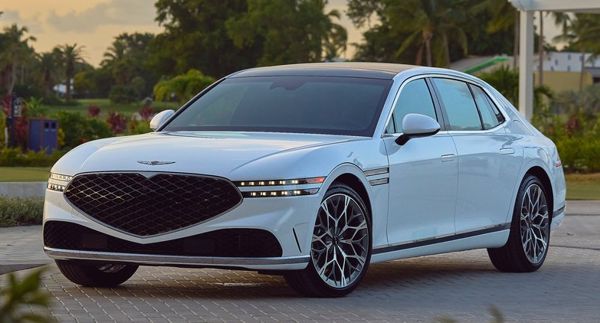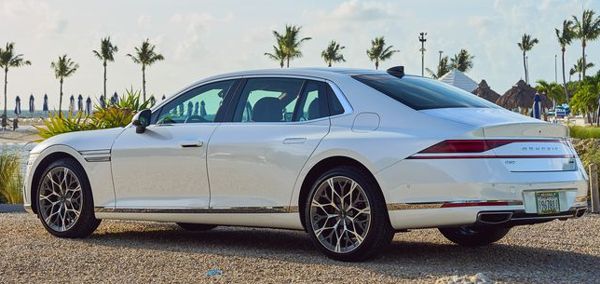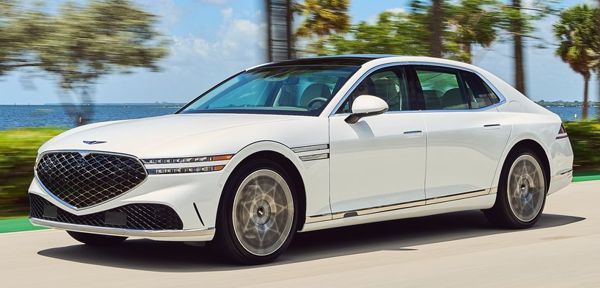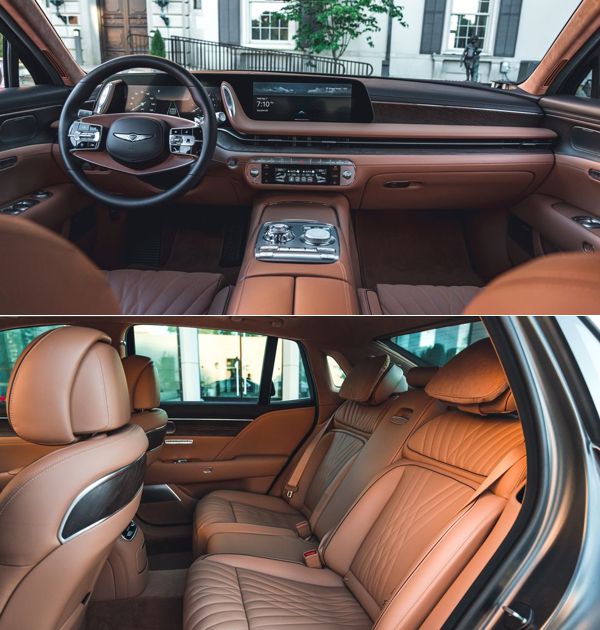Published
on 17
Nov 2022
|
All rights reserved.
|
|
|

|
|
New
Genesis flagship inches closer to the top of the class.
|
|
The last generation
Genesis G90 brought Hyundai to the heartland of large luxury car
segment. As pointed out in my last review, it was competitive in most
areas that customers count, but lacked the last 10 percent finish that
distinguishes the best from merely good. Here is the last 10 percent.
The progress Genesis made in the last few years has been amazing. G70
and G80 are rated among the best cars in their respective classes,
while the new GV60 electric SUV is another class act, although AutoZine
is not going to cover it. The luxury brand of Hyundai group is now so
capable, no matter in styling, powertrains, ride and handling,
refinement or build quality, that it has become a serious threat to
Mercedes, BMW, Audi and the like. In other words, it has already
leapfrogged the Japanese Lexus, Infiniti and Acura, as well as Volvo
and Jaguar in my opinion. The second generation G90 is another
statement that Genesis is not afraid to take on the best luxury car in
the world, i.e. Mercedes S-class.
One thing the Genesis might beat the peerless S-class is exterior
styling. While the massive diamond-shape mesh grille is flamboyant to
the extent of over the top, the whole bodywork has real character. It
is imposing yet pretty sleek. The arc waistline is beautiful. The tail
looks elegant. The C-pillar is beautifully shaped, has a sleeker take
on BMW’s Hofmeister kink. The long nose and long long bonnet have
strong presence. The double-stripe LED headlights are truly unique, and
they extend way beyond the front wheels in a coherent style. Overall,
it feels just as special as a Bentley. There is really nothing to imply
its relatively affordable price. The only downside is a very average
drag coefficient of 0.27, trailing the S-class by 0.05, but that’s a
price worth paying for.

|
|
Graceful
styling trumps many European rivals.
|
|
If you care about efficiency, yes, the Genesis is not quite as advanced
as the Mercedes. Its chassis is again made of steel, as aluminum is
reserved for suspensions. In addition to its huge dimensions – in
standard body it is nearly 100 mm longer than the S-class, while
long-wheelbase version is 176 mm longer than the LWB S-class – no
wonder it tips the scale at 2300 kg, 300 kg more than the equivalent
S-class.
On the plus side, its chassis feels rigid (12 percent stiffer than the
old car), and Genesis saves no money in NVH suppression. The noise
insulation is so good that its cabin is just as quiet as the Mercedes
in high-speed cruising. Moreover, it finally gets air suspension to
match its European counterparts, no wonder it rides smoothly over most
road surfaces. There are 3 drive modes: Comfort, Sport and Chauffeur –
the last one is designed for domestic market where most buyers let
their chauffeurs take the helm. Not even Sport would ruin the supple
ride manner.
As for handling, the new car has added 4-wheel steering, which makes it
feel smaller on twistier roads and easier to slip into tight parking
space. Moreover, all but the base model gets standard 4-wheel drive as
well, guaranteeing traction on less than perfect roads and weather. The
steering might be too light and numb for the liking of keener drivers,
but otherwise the Genesis’ ride and handling is up to class standards.

|
|
V6 is smooth
and effortless, though slightly hampered by 2.3 tons of car.
|
|
What it falls short of European standard is the powertrain, but that is
only because it lacks a full range of engines. While Mercedes allows
you to choose from straight-6 petrol and diesel, V8, V12 (for Maybach
version) or plug-in hybrid, Hyundai makes do with a single 3.5-liter
V6. There are actually 2 versions of the V6, one is served with
twin-turbo and produces 380 hp (as in G80), another adds a 48V electric
supercharger to aid low-end response and boosts output to 415 hp, along
with 405 lbft of torque instead of 391. Such difference is rather slim.
If it was Mercedes, I suppose it would skip the base engine and offer
only the more advanced one. As the base engine is not offered in the
US, I guess its existence is solely to capture company car sales in
Korea.
The tri-charger V6 is not a bad engine. It offers plenty of torque,
feels smooth and effortless in acceleration. It just trails the
straight-sixes of Mercedes and BMW a little in smoothness and sound
quality. However, owing to the 300 kg of extra weight, the G90 is
significantly slower in acceleration. According to Car and Driver, it
takes 5.1 seconds to go from 0-60 mph, half a second slower than the
Mercedes. It is also thirstier. While the Mercedes returns 24 mpg in
EPA combined cycle, the Hyundai manages only 20 mpg. Yes, fuel bills
matter little to those who could afford these luxury limousines, but
every little thing counts in the fight for top honour.
The biggest weakness of G90 is the lack of ambition. From its
powertrain selection, you can see Hyundai sets its sight in only Korea
and the USA, and focuses all its resources to the best selling model.
On the one hand it has no intention to challenge the powerful versions
of its German rivals, which is sensible, admittedly. On the other hand,
it avoids investing into plug-in hybrid and full-electric versions,
which is less sensible, because this means it has to sacrifice the
entire European market as well as sales to companies with corporate
social responsibility audits.
 |
|
It feels just
as expensive as the best German luxury cars...
|
|
However, considering the uphill battle Genesis is fighting, you have to
admire what it has achieved. The new G90 feels just as expensive as the
best German luxury cars. This is more evident when you open the doors,
which are power-operated and soft-closing as in Rolls-Royce. There are
bags of room for tall occupants both front and rear. The materials are
classy – stitched Nappa leather upholstery, wood and carbon inserts,
flashy metal control panels etc. Fit and finish is impeccable. The
switchgears are bespoke, no longer shared with lesser Hyundais, unlike
the old car. A flat panel accommodates a pair of 12.3-inch screens, one
for configurable instrument and another is the touchscreen of
infotainment system. Graphics are high definition and crisped. The
software responds immediately. Moreover, the Genesis’ cabin is more
user friendly than the Mercedes, as it leaves hardware buttons for
climate control and audio, as well as rotary control on transmission
tunnel for gear and mode selector. It is more traditional yet easier to
live with. The rear seat gets independent controls for climate and
infotainment at the center armrest. Again it consists of a touchscreen
and hardware buttons and dials.
Doubled as a chauffeur’s car, rear passenger comfort is not ignored, of
course. The rear seat is heated, cooled and incorporate massager
(though not hot-stone massager as in the case of Mercedes). When the
boss wants to take a rest, the kerb-side seat can recline, a leg
support emerges while the front passenger seat slides all the way
forward to free up legroom. That’s a Maybach level of luxury feature.
Moreover, the Genesis has a fantastic B&O sound system and a new
“mood curator”, which uses ambient lighting, sound, screen graphics,
fragrance and massaging to create a relaxing environment, and there are
4 mood modes to choose from. Ultimately, it is not quite as opulent as
the S-class’ cabin, nor its seats as comfortable, but its high level of
build quality and comfort may shock many European rivals. And then
consider the keener pricing and the gorgeous look, we have never been
so optimistic about the prospect of Korean luxury cars.
|
Verdict:     |
|